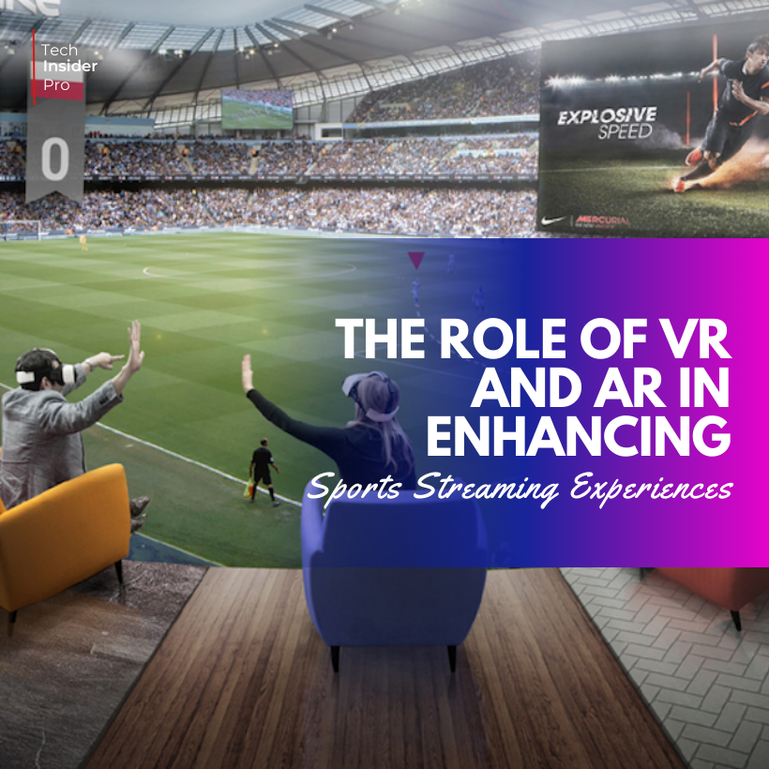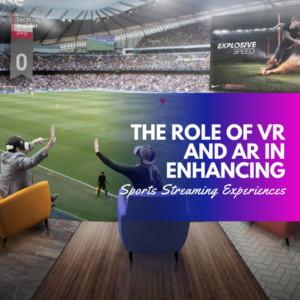
Introduction
The Evolution of Sports Streaming in Brief
There have been dramatic shifts in the sports broadcasting industry in the last several decades, with the medium moving away from static television and toward more dynamic, user-friendly digital streaming services. Innovations in technology and the rising popularity of on-demand content have prompted this change.
Importance of AR and VR Technology

Leading the charge to revolutionize sports viewing are VR and AR technologies. To satisfy the needs of a tech-savvy audience looking for more engaging material, these technologies not only offer immersive experiences but also add layers of interaction and information that were previously inconceivable.
How Virtual Reality Is Changing Sports Streaming
Full-screen entertainment virtual reality (VR) has changed the way sports are streamed by giving viewers the sensation of being in the stadium. For instance, with virtual reality platforms, spectators can experience a game from a player’s point of view, pick their own viewing location, and see it from a variety of angles. The audience’s emotional and sensory involvement is greatly enhanced by this degree of immersion.
VR features and abilities controllable live-action replays and 360-degree movies are two of virtual reality’s most appealing qualities for use in sports. With these additions, fans may experience pivotal moments from any perspective, expanding their knowledge of the game beyond what is possible with conventional viewing techniques.
AR Function in Raising Audience Participation

Data overlays in real time viewers can access player stats, game dynamics, and more in real-time with augmented reality (AR), which adds a data and graphic layer to the live broadcast. Take a soccer match as an example. Augmented reality may subtly show things like player stamina, distance run, and tactical formations.
Improving the fun for fans in addition to data, augmented reality can overlay animated play analysis onto the field, illuminating intricate game strategy and decisions for spectators. By giving insights normally reserved for professional analysts, this software does double duty: it teaches the audience and keeps them engaged.
The Use of VR and AR in Well-Known Sports Streaming Platforms

ESPN+
To better serve its subscribers, ESPN+ has been an early adopter of virtual reality and augmented reality features. Using augmented reality, the platform allows users to see game dynamics, player heat maps, and real-time statistics on their screen while watching live sports events. Fans may immerse themselves in the game’s subtleties and have a more immersive viewing experience as a result.
DAZN
DAZN uses virtual reality technology to provide a unique way to watch sports, especially boxing matches. With the ability to view fights from all around the ring, fans can feel more immersed in the action and emotions of the bout than ever before. Fans of the sport who value strategy and physical prowess will find this perspective particularly interesting.
Sky Sports
In order to better explain intricate strategies and plays in sports like cricket and football, Sky Sports uses augmented reality to supplement live broadcasts with visual upgrades. By making the analysis more interactive and intelligible, this technology helps retain viewers and enhances their involvement with the information overall.
Fox Sports
To give fans a taste of what it’s like to be at a stadium, Fox Sports has embraced virtual reality. From the sidelines to the stands, fans have a choice of viewing locations across the stadium, allowing for a personalized experience. This virtual reality (VR) integration not only piques the interest of tech-savvy viewers, but it also provides Fox Sports with a distinct competitive advantage.
NBC Sports
In order to put viewers in the thick of the action during the Olympics, NBC Sports uses augmented reality. Athletes can have their routes projected, records highlighted, and statistics and outcomes presented more visually with the help of augmented reality. The use of augmented reality brings the intricate nuances of different Olympic sports to a worldwide audience in a way that is both accessible and fascinating.
The Role of Technology in Keeping Viewers

Virtual reality and augmented reality features have been an important component in the audience retention rates of sports streaming platforms such as ESPN+, DAZN, Sky Sports, Fox Sports, and NBC Sports. More happiness and loyalty from viewers is a direct result of the enhanced interactivity and engagement made possible by these technologies. Virtual Reality (VR) and Augmented Reality (AR) features not only entice new customers, but also keep existing ones happy with the improved viewing experience. Further, these platforms are continually improving their technological offerings to meet the wants of viewers and stay up-to-date with innovations, guaranteeing client happiness and long-term involvement.
Advantages for Rights Holders and Broadcasters
Potentially lucrative new ventures, virtual commercials, sponsorships integrated into the VR experience, and premium memberships for exclusive AR content are some of the new revenue sources made possible by VR and AR. With these openings, broadcasters may reach more people and provide them with ads that are more relevant to them depending on their behaviours and interests.
New content development using virtual reality and augmented reality, broadcasters may provide viewers with fresh, original material that sets them apart from the competition. Offering fans more than just the usual game broadcasts, this includes special virtual reality tours of behind-the-scenes areas, incorporation of augmented reality into fantasy sports, and much more besides.
Difficulties and Restriction
Financial and technical obstacles spending a lot of money on tech and content creation is necessary to implement VR and AR. Major barriers to broad adoption are the expensive price of VR gear and the requirement for high-bandwidth internet connections.
Disabilities facing users problems with VR and AR becoming commonplace include the need for specialized hardware and individuals’ varied levels of computer proficiency. Furthermore, there may be skepticism from more conventional sports fans who prefer more traditional forms of entertainment.
VR and AR Potential for The Future of Live Sports Streaming

Recent developments in technology, better integration, cheaper prices, and more interactive features are likely to be forthcoming VR and AR innovations that could appeal to a wider audience. New developments, such enhanced haptic feedback systems in virtual reality, have the potential to replicate the tangible feelings of being present at a sporting event, thereby heightening the total immersion. These advancements herald a promising future of live sports streaming, transforming how fans engage with sports events globally.
Looking ahead at fan engagement the ways in which sports fans engage with material will also change as technology advances. More individualized watching options, insights into games powered by AI, and social experiences powered by AR and VR, allowing fans to virtually watch games with pals, are all on the horizon.
In Summary
Concluding the results, virtual reality and augmented reality are quickly changing the way sports are streamed. These technologies provide up new avenues of revenue for broadcasters while simultaneously improving the audience experience through the provision of interactive and immersive content. Moving Forward Looking forward, the ongoing advancement and incorporation of virtual reality and augmented reality into sports streaming hold great potential to further transform the way fans interact with their beloved athletic events. As these technologies continue to advance, they will surely transform the sports broadcasting industry, turning every game into a thrilling new viewing experience.





